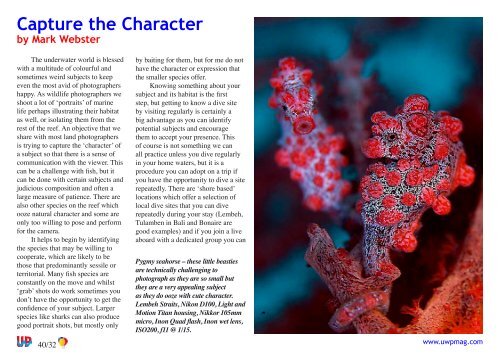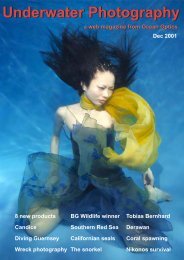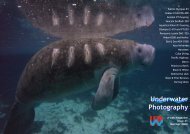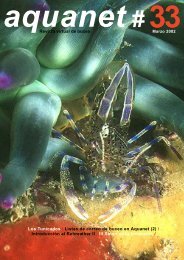Underwater Photography Underwater Photography
Underwater Photography Underwater Photography
Underwater Photography Underwater Photography
You also want an ePaper? Increase the reach of your titles
YUMPU automatically turns print PDFs into web optimized ePapers that Google loves.
Capture the Character<br />
by Mark Webster<br />
The underwater world is blessed<br />
with a multitude of colourful and<br />
sometimes weird subjects to keep<br />
even the most avid of photographers<br />
happy. As wildlife photographers we<br />
shoot a lot of ‘portraits’ of marine<br />
life perhaps illustrating their habitat<br />
as well, or isolating them from the<br />
rest of the reef. An objective that we<br />
share with most land photographers<br />
is trying to capture the ‘character’ of<br />
a subject so that there is a sense of<br />
communication with the viewer. This<br />
can be a challenge with fish, but it<br />
can be done with certain subjects and<br />
judicious composition and often a<br />
large measure of patience. There are<br />
also other species on the reef which<br />
ooze natural character and some are<br />
only too willing to pose and perform<br />
for the camera.<br />
It helps to begin by identifying<br />
the species that may be willing to<br />
cooperate, which are likely to be<br />
those that predominantly sessile or<br />
territorial. Many fish species are<br />
constantly on the move and whilst<br />
‘grab’ shots do work sometimes you<br />
don’t have the opportunity to get the<br />
confidence of your subject. Larger<br />
species like sharks can also produce<br />
good portrait shots, but mostly only<br />
40/ 2<br />
by baiting for them, but for me do not<br />
have the character or expression that<br />
the smaller species offer.<br />
Knowing something about your<br />
subject and its habitat is the first<br />
step, but getting to know a dive site<br />
by visiting regularly is certainly a<br />
big advantage as you can identify<br />
potential subjects and encourage<br />
them to accept your presence. This<br />
of course is not something we can<br />
all practice unless you dive regularly<br />
in your home waters, but it is a<br />
procedure you can adopt on a trip if<br />
you have the opportunity to dive a site<br />
repeatedly. There are ‘shore based’<br />
locations which offer a selection of<br />
local dive sites that you can dive<br />
repeatedly during your stay (Lembeh,<br />
Tulamben in Bali and Bonaire are<br />
good examples) and if you join a live<br />
aboard with a dedicated group you can<br />
Pygmy seahorse – these little beasties<br />
are technically challenging to<br />
photograph as they are so small but<br />
they are a very appealing subject<br />
as they do ooze with cute character.<br />
Lembeh Straits, Nikon D100, Light and<br />
Motion Titan housing, Nikkor 105mm<br />
micro, Inon Quad flash, Inon wet lens,<br />
ISO200, f11 @ 1/15.<br />
www.uwpmag.com

















